Tianzhu Ye
Step by Step Network
Nov 18, 2025Abstract:Scaling up network depth is a fundamental pursuit in neural architecture design, as theory suggests that deeper models offer exponentially greater capability. Benefiting from the residual connections, modern neural networks can scale up to more than one hundred layers and enjoy wide success. However, as networks continue to deepen, current architectures often struggle to realize their theoretical capacity improvements, calling for more advanced designs to further unleash the potential of deeper networks. In this paper, we identify two key barriers that obstruct residual models from scaling deeper: shortcut degradation and limited width. Shortcut degradation hinders deep-layer learning, while the inherent depth-width trade-off imposes limited width. To mitigate these issues, we propose a generalized residual architecture dubbed Step by Step Network (StepsNet) to bridge the gap between theoretical potential and practical performance of deep models. Specifically, we separate features along the channel dimension and let the model learn progressively via stacking blocks with increasing width. The resulting method mitigates the two identified problems and serves as a versatile macro design applicable to various models. Extensive experiments show that our method consistently outperforms residual models across diverse tasks, including image classification, object detection, semantic segmentation, and language modeling. These results position StepsNet as a superior generalization of the widely adopted residual architecture.
Black-Box On-Policy Distillation of Large Language Models
Nov 13, 2025Abstract:Black-box distillation creates student large language models (LLMs) by learning from a proprietary teacher model's text outputs alone, without access to its internal logits or parameters. In this work, we introduce Generative Adversarial Distillation (GAD), which enables on-policy and black-box distillation. GAD frames the student LLM as a generator and trains a discriminator to distinguish its responses from the teacher LLM's, creating a minimax game. The discriminator acts as an on-policy reward model that co-evolves with the student, providing stable, adaptive feedback. Experimental results show that GAD consistently surpasses the commonly used sequence-level knowledge distillation. In particular, Qwen2.5-14B-Instruct (student) trained with GAD becomes comparable to its teacher, GPT-5-Chat, on the LMSYS-Chat automatic evaluation. The results establish GAD as a promising and effective paradigm for black-box LLM distillation.
SeerAttention-R: Sparse Attention Adaptation for Long Reasoning
Jun 10, 2025



Abstract:We introduce SeerAttention-R, a sparse attention framework specifically tailored for the long decoding of reasoning models. Extended from SeerAttention, SeerAttention-R retains the design of learning attention sparsity through a self-distilled gating mechanism, while removing query pooling to accommodate auto-regressive decoding. With a lightweight plug-in gating, SeerAttention-R is flexible and can be easily integrated into existing pretrained model without modifying the original parameters. We demonstrate that SeerAttention-R, trained on just 0.4B tokens, maintains near-lossless reasoning accuracy with 4K token budget in AIME benchmark under large sparse attention block sizes (64/128). Using TileLang, we develop a highly optimized sparse decoding kernel that achieves near-theoretical speedups of up to 9x over FlashAttention-3 on H100 GPU at 90% sparsity. Code is available at: https://github.com/microsoft/SeerAttention.
Reinforcement Pre-Training
Jun 09, 2025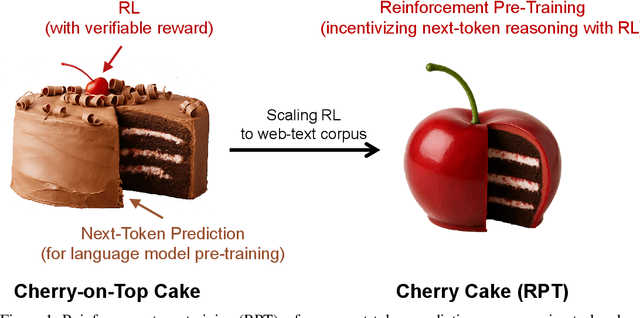
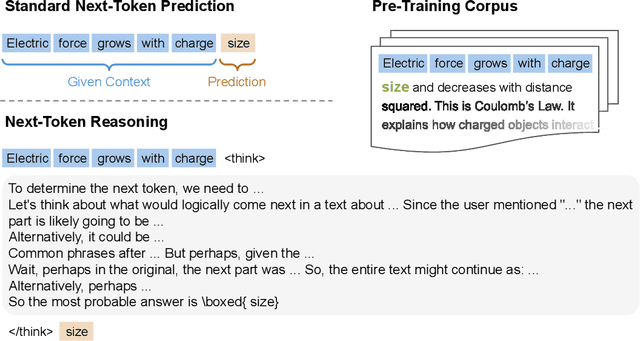


Abstract:In this work, we introduce Reinforcement Pre-Training (RPT) as a new scaling paradigm for large language models and reinforcement learning (RL). Specifically, we reframe next-token prediction as a reasoning task trained using RL, where it receives verifiable rewards for correctly predicting the next token for a given context. RPT offers a scalable method to leverage vast amounts of text data for general-purpose RL, rather than relying on domain-specific annotated answers. By incentivizing the capability of next-token reasoning, RPT significantly improves the language modeling accuracy of predicting the next tokens. Moreover, RPT provides a strong pre-trained foundation for further reinforcement fine-tuning. The scaling curves show that increased training compute consistently improves the next-token prediction accuracy. The results position RPT as an effective and promising scaling paradigm to advance language model pre-training.
Rectified Sparse Attention
Jun 05, 2025Abstract:Efficient long-sequence generation is a critical challenge for Large Language Models. While recent sparse decoding methods improve efficiency, they suffer from KV cache misalignment, where approximation errors accumulate and degrade generation quality. In this work, we propose Rectified Sparse Attention (ReSA), a simple yet effective method that combines block-sparse attention with periodic dense rectification. By refreshing the KV cache at fixed intervals using a dense forward pass, ReSA bounds error accumulation and preserves alignment with the pretraining distribution. Experiments across math reasoning, language modeling, and retrieval tasks demonstrate that ReSA achieves near-lossless generation quality with significantly improved efficiency. Notably, ReSA delivers up to 2.42$\times$ end-to-end speedup under decoding at 256K sequence length, making it a practical solution for scalable long-context inference. Code is available at https://aka.ms/ReSA-LM.
Differential Transformer
Oct 07, 2024



Abstract:Transformer tends to overallocate attention to irrelevant context. In this work, we introduce Diff Transformer, which amplifies attention to the relevant context while canceling noise. Specifically, the differential attention mechanism calculates attention scores as the difference between two separate softmax attention maps. The subtraction cancels noise, promoting the emergence of sparse attention patterns. Experimental results on language modeling show that Diff Transformer outperforms Transformer in various settings of scaling up model size and training tokens. More intriguingly, it offers notable advantages in practical applications, such as long-context modeling, key information retrieval, hallucination mitigation, in-context learning, and reduction of activation outliers. By being less distracted by irrelevant context, Diff Transformer can mitigate hallucination in question answering and text summarization. For in-context learning, Diff Transformer not only enhances accuracy but is also more robust to order permutation, which was considered as a chronic robustness issue. The results position Diff Transformer as a highly effective and promising architecture to advance large language models.
Agent Attention: On the Integration of Softmax and Linear Attention
Dec 22, 2023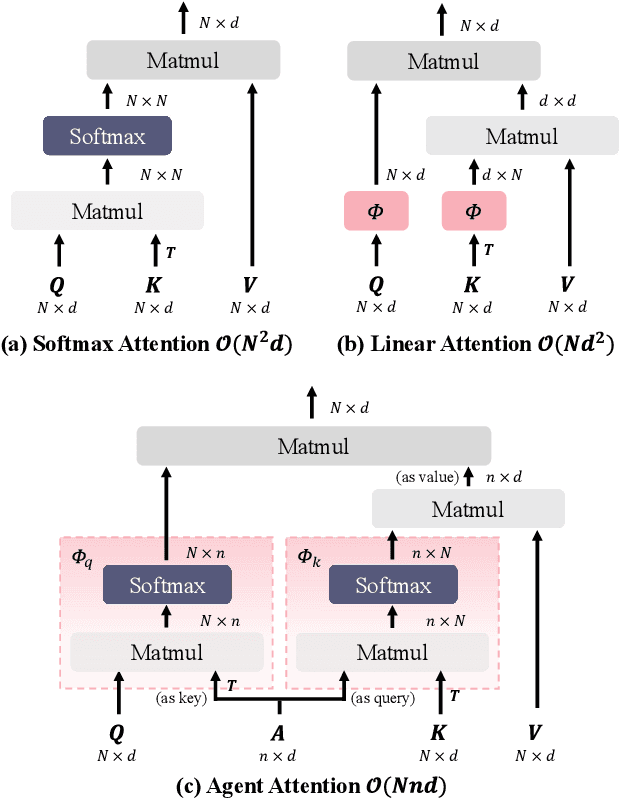
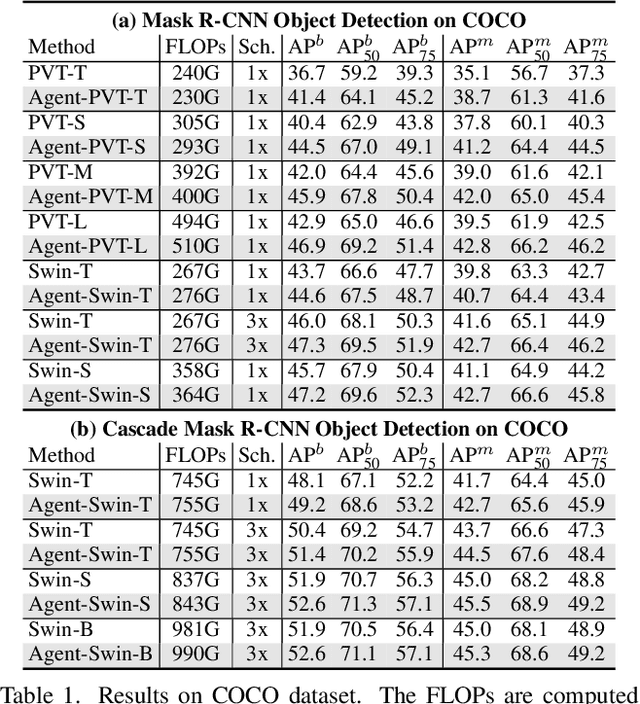

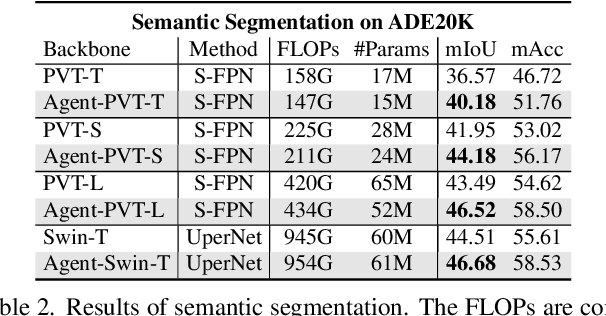
Abstract:The attention module is the key component in Transformers. While the global attention mechanism offers high expressiveness, its excessive computational cost restricts its applicability in various scenarios. In this paper, we propose a novel attention paradigm, Agent Attention, to strike a favorable balance between computational efficiency and representation power. Specifically, the Agent Attention, denoted as a quadruple $(Q, A, K, V)$, introduces an additional set of agent tokens $A$ into the conventional attention module. The agent tokens first act as the agent for the query tokens $Q$ to aggregate information from $K$ and $V$, and then broadcast the information back to $Q$. Given the number of agent tokens can be designed to be much smaller than the number of query tokens, the agent attention is significantly more efficient than the widely adopted Softmax attention, while preserving global context modelling capability. Interestingly, we show that the proposed agent attention is equivalent to a generalized form of linear attention. Therefore, agent attention seamlessly integrates the powerful Softmax attention and the highly efficient linear attention. Extensive experiments demonstrate the effectiveness of agent attention with various vision Transformers and across diverse vision tasks, including image classification, object detection, semantic segmentation and image generation. Notably, agent attention has shown remarkable performance in high-resolution scenarios, owning to its linear attention nature. For instance, when applied to Stable Diffusion, our agent attention accelerates generation and substantially enhances image generation quality without any additional training. Code is available at https://github.com/LeapLabTHU/Agent-Attention.
FAAC: Facial Animation Generation with Anchor Frame and Conditional Control for Superior Fidelity and Editability
Dec 20, 2023



Abstract:Over recent years, diffusion models have facilitated significant advancements in video generation. Yet, the creation of face-related videos still confronts issues such as low facial fidelity, lack of frame consistency, limited editability and uncontrollable human poses. To address these challenges, we introduce a facial animation generation method that enhances both face identity fidelity and editing capabilities while ensuring frame consistency. This approach incorporates the concept of an anchor frame to counteract the degradation of generative ability in original text-to-image models when incorporating a motion module. We propose two strategies towards this objective: training-free and training-based anchor frame methods. Our method's efficacy has been validated on multiple representative DreamBooth and LoRA models, delivering substantial improvements over the original outcomes in terms of facial fidelity, text-to-image editability, and video motion. Moreover, we introduce conditional control using a 3D parametric face model to capture accurate facial movements and expressions. This solution augments the creative possibilities for facial animation generation through the integration of multiple control signals. For additional samples, please visit https://paper-faac.github.io/.
Joint Token Pruning and Squeezing Towards More Aggressive Compression of Vision Transformers
Apr 21, 2023



Abstract:Although vision transformers (ViTs) have shown promising results in various computer vision tasks recently, their high computational cost limits their practical applications. Previous approaches that prune redundant tokens have demonstrated a good trade-off between performance and computation costs. Nevertheless, errors caused by pruning strategies can lead to significant information loss. Our quantitative experiments reveal that the impact of pruned tokens on performance should be noticeable. To address this issue, we propose a novel joint Token Pruning & Squeezing module (TPS) for compressing vision transformers with higher efficiency. Firstly, TPS adopts pruning to get the reserved and pruned subsets. Secondly, TPS squeezes the information of pruned tokens into partial reserved tokens via the unidirectional nearest-neighbor matching and similarity-based fusing steps. Compared to state-of-the-art methods, our approach outperforms them under all token pruning intensities. Especially while shrinking DeiT-tiny&small computational budgets to 35%, it improves the accuracy by 1%-6% compared with baselines on ImageNet classification. The proposed method can accelerate the throughput of DeiT-small beyond DeiT-tiny, while its accuracy surpasses DeiT-tiny by 4.78%. Experiments on various transformers demonstrate the effectiveness of our method, while analysis experiments prove our higher robustness to the errors of the token pruning policy. Code is available at https://github.com/megvii-research/TPS-CVPR2023.
Slide-Transformer: Hierarchical Vision Transformer with Local Self-Attention
Apr 09, 2023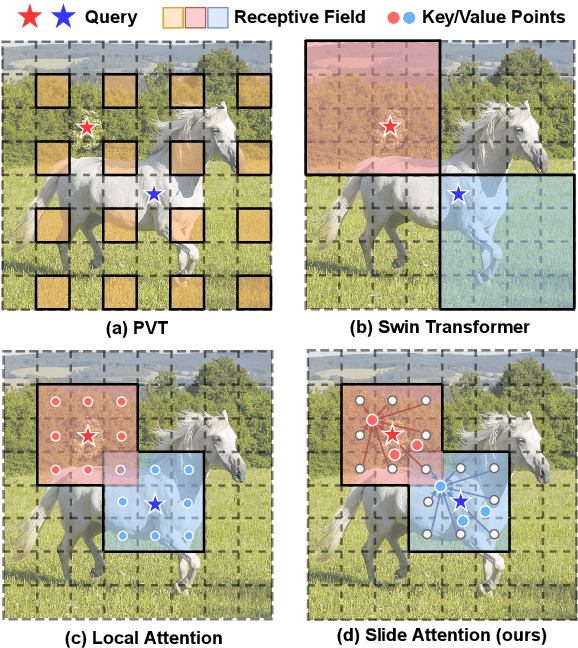
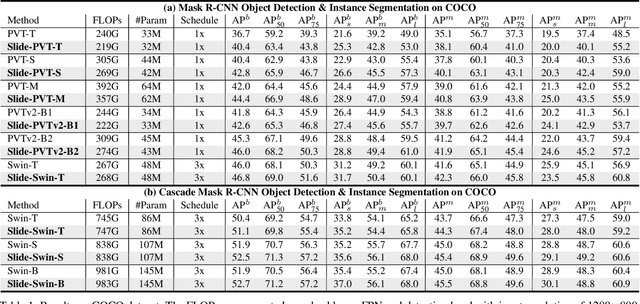
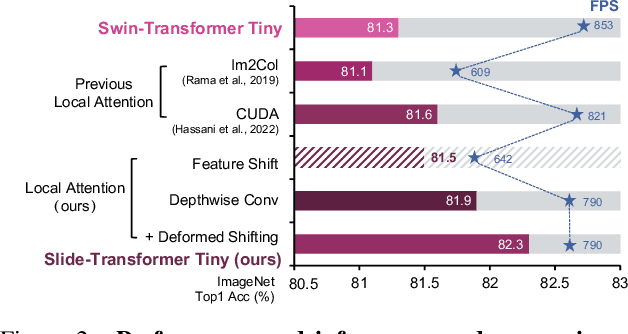
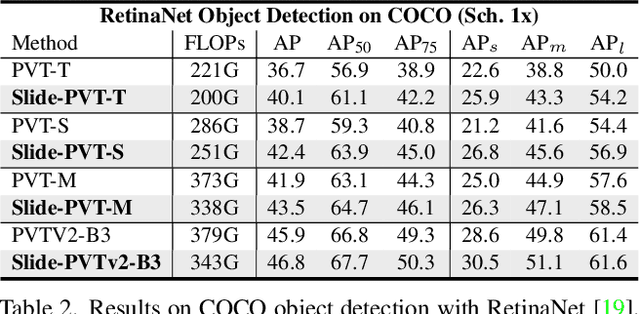
Abstract:Self-attention mechanism has been a key factor in the recent progress of Vision Transformer (ViT), which enables adaptive feature extraction from global contexts. However, existing self-attention methods either adopt sparse global attention or window attention to reduce the computation complexity, which may compromise the local feature learning or subject to some handcrafted designs. In contrast, local attention, which restricts the receptive field of each query to its own neighboring pixels, enjoys the benefits of both convolution and self-attention, namely local inductive bias and dynamic feature selection. Nevertheless, current local attention modules either use inefficient Im2Col function or rely on specific CUDA kernels that are hard to generalize to devices without CUDA support. In this paper, we propose a novel local attention module, Slide Attention, which leverages common convolution operations to achieve high efficiency, flexibility and generalizability. Specifically, we first re-interpret the column-based Im2Col function from a new row-based perspective and use Depthwise Convolution as an efficient substitution. On this basis, we propose a deformed shifting module based on the re-parameterization technique, which further relaxes the fixed key/value positions to deformed features in the local region. In this way, our module realizes the local attention paradigm in both efficient and flexible manner. Extensive experiments show that our slide attention module is applicable to a variety of advanced Vision Transformer models and compatible with various hardware devices, and achieves consistently improved performances on comprehensive benchmarks. Code is available at https://github.com/LeapLabTHU/Slide-Transformer.
 Add to Chrome
Add to Chrome Add to Firefox
Add to Firefox Add to Edge
Add to Edge